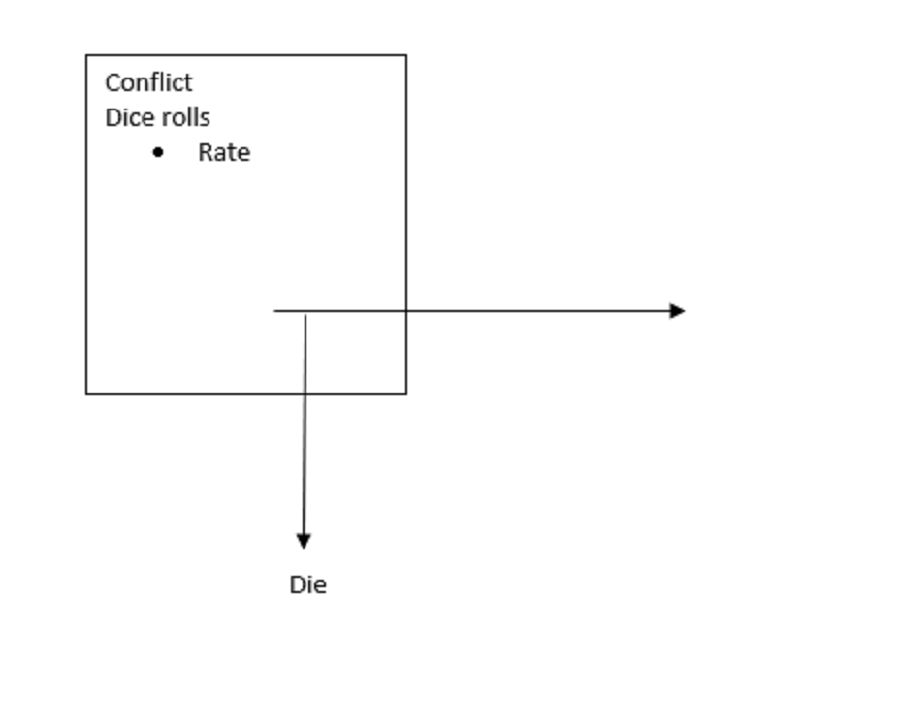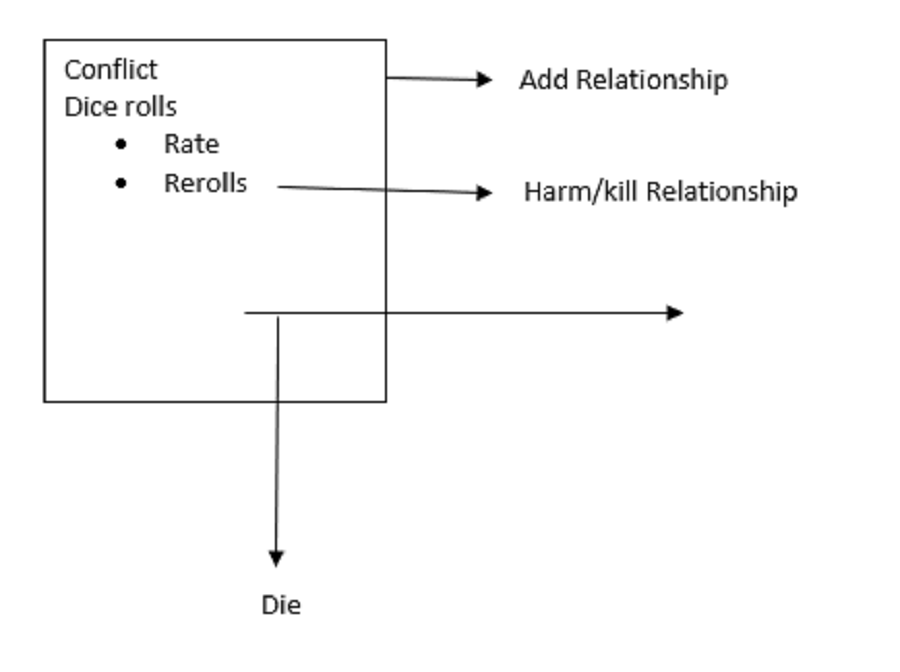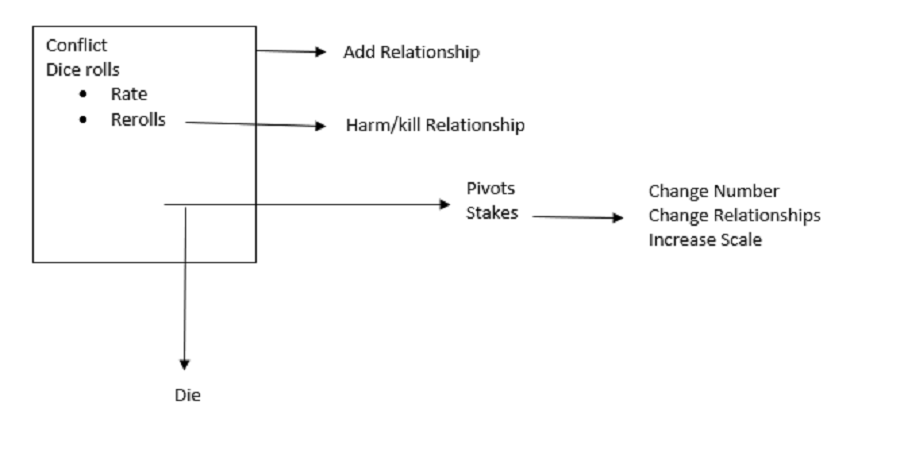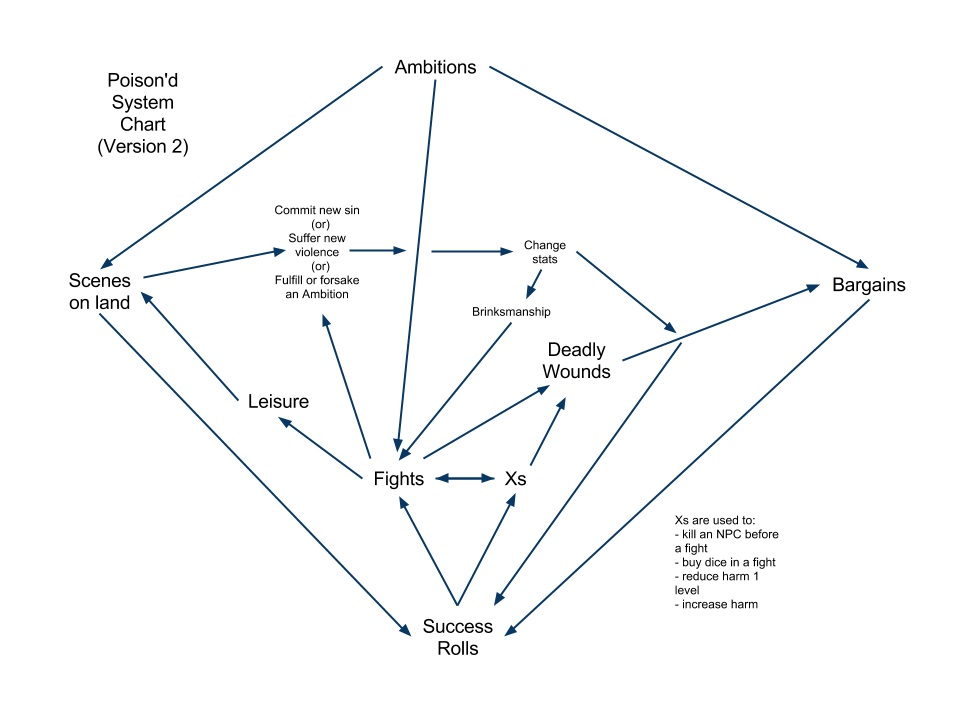I’ve been drawing these things for years. I’ve rarely discussed them publicly for a couple reasons, but busted one out for my Understanding the Pool seminar, and got to thinking about them again. Then Jason, who was saving my sanity regarding Adobe Premiere, asked me about them outta the blue, based on a discussion about Poison’d and Steve Hickey’s chart for that game, reproduced here:
That led to a little discussion, during which we diagrammed Trollbabe and Gregor Hutton’s 3:16, and lots to follow up on from there. Please forgive the Very Big Jason and the Itsy Bitsy Me screens; I’m still hashin’ out interfaces for these things.
I’ll follow up in the comments on some of the stuff we mentioned, including diagrams for the general point about (a lot of) D&D, Mars Colony, Nine Worlds, and carry.






14 responses to “Conversation: System diagrams”
3:16 final diagram
This shows the final version that emerged verbally.
I included the single GM contribution to play, which is managing the Threat tokens during a mission – Jason and I discussed this as a throttle mechanism regarding the units/degree of danger. In this game, aside from providing as much colorful description and characterization as he or she wants, the GM really doesn't do anything else.
More important, it now shows how the ongoing character development feeds back into play – most obviously, that promotions mean that one or more characters contribute directly to the new threats to the other characters.*
I stress again, as I mentioned in the video, that the two development tracks (promotion, complexity/disillusion) are not exclusive. A given character can max out on both, max on one and be minimal on the other, or (conceivably but unlikely) be minimal for both. If they were exclusive, the system would be more competitive, baking in player conflict of interest over the in-game abstractions of "death" as a loss feature and "rank" as an advantage. That might be a fun game but it is not this game, which instead yields organic, contingent, and complicated conflicts for the characters based on (i) very local and immediate outcomes and (ii) the prevailing militarism.
Another observation about the video, directly to you Jason, which wasn't as clear to me in the thick of the conversation, is how much you had focused initially on combat options in your preliminary scan of the system. Although you'd picked up on all the anti-war content that we talked about and considered it as obvious as I did, systemically, you "saw" a genuine focus on now we fight bugs tactically. In the context of the diagram, those rules are present as an arena of tension between survival and promotion, not as a problem to be solved as a challenge "of the game."
I suspect that here's where the disconnect I kept talking about occurred, historically. You say, "how do we play," and the person answers with all this talk about weapon range and movement options, and there you go.
* Finagling some way to get the senior rank characters into the mission after all is a fine use of NFA during the briefing scene …
Diggin' the title card. Looks good.
Thanks! My hope is that the videos’ roughness is offset by their evident improvement as I go along, with any luck, rapid improvement. The next thing is to get the hell out of the attic! I have ideal filming space downtown, but it’s hard to use it in the evenings when I’m interacting across time zones.
Some comments…
Hi! Where are the links to the 3:16 actual plays cited in the video? I could swear that I had seen them in one comment…
I would be interested in the RuneQuest diagram, too!
About 3:16 and "what it was really about" , it was really clear to me from the text after a first read: the "evolution" of the character would give them, at the end:
1) "hatred for home",
2) the final decision about the fleet movement and next target,
3) the hand on the button of a weapon able to destroy the entire solar system.
Add, 1+2+3, the math is simple. TOO simple, maybe: it made me consider it a little too railroady. But I had not considered the parts between the fights (that is almost absent from the manual too)
Why most people didn't get that math and they though of the game as shoot-them-up? This too is very simple: in this rpg culture, NOBODY read the manuals. Ever. The players read only their character sheets and maybe the weapon charts, the GM reads only the parts he thinks he need for the next session, and skip the fiction and the advices. I doubt very much that most of the players had read or noticed that "hatred for home" bit.
About: "In this game, aside from providing as much colorful description and characterization as he or she wants the GM really doesn't do anything else". It's funny that you treat that as a "only that, it's not so much". The thought to have to improvise everything between battles? Even the thought exhaust me… 🙂
At the first reading I got the impression that the game was played almost only during the invasions, but even the first try did show us that the game could not possibly work like that. But after that first try we put the game aside until I was able to play it with Gregor as the GM at a Italian convention (I even got a medal!) and I could see how it really worked. And I think it really, really need a GM with histrionic qualities that can improvise almost everything on the fly (or that could play a lot of different military characters in his sleep…). At least at the beginning the grunt-level of the characters means that in almost every scene most of the acting and the dialogue will be done by the GM…
Thanks for spotting that! I think I accidentally deleted them when editing the image format.
Here are threads with my play-experiences, beginning with a discussion of someone else's:
[3: 16] Way Too Easy Or Just Got the Rules Wrong?
[3:16] Semi-Captain, Lt.-Captain, almost-Captain on deck, sir!
[3:16] Home is for the hating
[3:16] Another damned Bambi! Shoot it, shoot it! AK-K-K-K-K!
Others' threads are here:
[3:16] Planet Bosch: Stop Picking At It
[3:16] On the South Coast… (at IndieCon)
[3:16] the betrayal of planet Girlfriend (especially this one)
[3:16] Screw-Ups and Monstrous Troopers
[3:16] Does It Encourage "We didn't roll the dice for three sessions!" Behavior?
Right now I'm a little hesitant to link these, because I've had this conversation with you before and I don't want to go the usual route. This isn't a discussion about texts as explanations and training. I don't want to talk about whether the game text does a good job. I know I brought up the issue of "why do people encounter this confusion" in the video – but not as a problem to solve, only as a reason to focus on the diagrams.
Let's talk about how the diagram works, with the fact that people didn't do it as the relevant point, not why they didn't.
Hatred for Home
I think I’m agreeing here by saying I always thought of “Hatred for Home” as a phase of play rather than a particular outcome or sequence of events.
And in my mind I don’t know what we’ll do as a group when prompted by that option. We’ll find out when we get there as a group with our characters developed in play and the GM’s universe view sharpened by what’s happened in play.
Though maybe that it is visible on every character sheet as a future state led to people short-circuiting in their mind what that meant or how it would turn out before they got there.
(Currently at WarpCon games convention in Cork, Ireland. Will catch up with the seminar and thinking when I’m back in Edinburgh.)
From the accounts at the
From the accounts at the linked threads, and from similar accounts described to me in person, I think the problem or trend or whatever we call it is the opposite of that. It's too close to the immediate now rather than too focused on the far end.
By immediate now (a phrase that would ordinarily be a positive thing coming from me), I mean "look, weapon types, types of armor, wound levels, range-move-attack tactics, so this is what we do." The kind of play when you fist-pump when the orbital nuke strike sequence is activated.
Particularly in convention play, or in a certain kind of over-mannered "now we are checking this game out" play, this hyper-attention and specificity is the default. Moreno's also right in pointing out that we're not talking about multiple readings of the text, but rather single semi-readings filtered out into a group perception dynamic. I'd add to that my current favorite topic of distinguishing between texts as explanations vs. texts as pedagogy. The net effect is for those combat-immediate details to enter the mental "how does this game work, what do we do" space and to expand there, filling it all in, and categorizing anything else that may get said (whether clearly and well-timed or not, more than likely not) as fluff.
I’d love to see the text from
I'd love to see the text from Tim Koppang on toys; but I can't seem to find it on the web. Anyone got a link? Please?
“Wind-Up Toys”
I was able to find a couple threads where I mention “toy” or “wind-up toy” design. The first I could find is from 2009 back when I was finalizing the Mars Colony design. It’s an actual play thread from the Forge. Here’s an archived copy I kept, but I’m sure I could find the indie-rpg link if I tried.
http://www.tckroleplaying.com/marscolony/Mars_Colony_AP-Just_a_little_lying-this_once.html
The second, and more substantial, is from the Story Games forum. Jason is quoting me from somewhere else. In part, it was from another thread on Story Games, but I also think I was talking about the concept somewhere on G+ (but I’ll be damned if I can find anything there because the place is a like a blackhole for comments).
http://story-games.com/forums/discussion/comment/280820/
More than the “wind-up toy” terminology, which was me being provocative, the key is creative expectations. To quote myself from the above thread (always fun): "How much does a particular game design expect of me creatively?” vs. how much does the game provide ready-made? It’s an important question for me, especially so when designing two-player games.
From later in the thread, I think Gregor and Paul have some excellent insight into what I was attempting to design. Here's a quote from Paul on what I was calling wind-up toy design, but which he argues should be labeled something else:
The idea that games should allow different groups across time to experience nearly the same sort of events in-game is assuredly relevant to what I was trying to describe. I don't personally believe in a design philosophy that would allow for such things. My preferences run towards game that (1) allow the game to fail because of "bad play" by the participants, and (2) require participants to bring proactive creative input to table in order to make the game successful — and maybe even move forward.
– Tim
Thanks a lot! I just realized
Thanks a lot! I just realized what "wind up" means. I needed to understand whether thie was in any way related to the "toy vs game" debates, and it seems pretty clear it doesn't. I mean, this doesn't seem related to goals at all. But I guess I'll know better after I've finished reading. Thanks again!
Hi Tim! My memory of the
Hi Tim! My memory of the topic came from our drive to GenCon 2009 when we were stuck in Chicago traffic, in high summer, and had nothing better to do than exchange current unmoderated rants about Gamers These Days.
Santiago, my understanding is that this has little if anything to do with the more general or goals-focused toys/games distinction.
Diagramming
Thanks again for the talk, Ron!
I had been wanting to connect all the disparate parts and subsystems, but I have found it so useful to just concentrate on the "moving parts" as we were calling them.
I've made diagrams part of my end-stage note-taking for the games I'm reading now. So far I have made diagrams for Bubblegumshoe, Apocalypse World, and The Watch (which I just finished reading). None of mine look as streamlined as your 3:16 diagram, but each one I have done has gotten a little more focused, cutting, I hope, to the heart of the matter.
What I'm interested to do next is diagram a game from the text of a game I haven't played, and then play several games and see how the diagram matches up to the played experience. Have you had to revise or reconsider a diagram after playing?
And while I'm here, let me say the new site looks fantastic!
Jason
(Ooh! I just previewed my comment and it looks like the apostrophe in my name is being translated in the classic ' configuration! Hoping it doesn't actually do that.)
I’d be really interested to
I'd be really interested to see what you've come up with for Apocalypse World. I think our mention of it was in a section I snipped out 'cause it wandered a lot and I wanted this presentation to be one clear argument. But a piece I regretted losing concerned comparing diagrams across "Powered by" games; in my case, games I've played like World Wide Wrestling, but as I understand them without playing yet, Diaspora, Monsterhearts, and The Bloody-Handed Names of Bronze.
Your apostrophe looks fine.
The point about “don’t
The point about "don't diagram everything" is crucial. For example …
Experientially, each of these is one of the most important parts of the game, but the diagrams aren't intended to teach how to play at that what-do-I-roll level. They are a means for understanding the game through a particular lens, a very important lens which is often overlooked in the thick of "who narrates? OMG!" or choices about how much damage to do vs. how much weight to carry.
All of this clarifies, and as I see it has clarified for a long time, the tiresome yipyap about what I've referred to as reward cycles and play cycles. These things are right here in the diagrams, at their various scales in terms of both fictional time and real time, with the relevant differences among games readily apparent, and they're not handwaving.